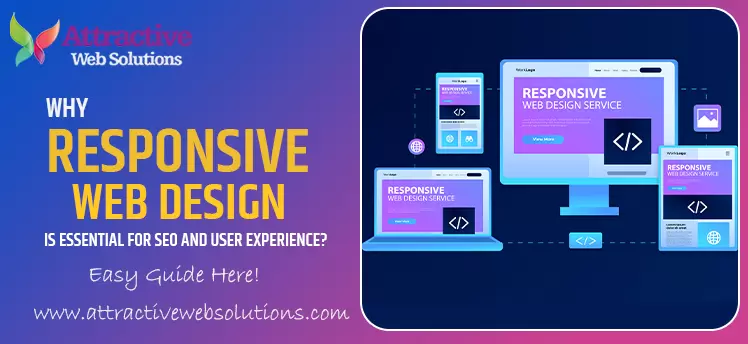In today’s digital age, where people use a wide array of devices to browse the internet, responsive web design is a crucial factor in web development. A responsive website adapts seamlessly to different screen sizes and devices, offering a consistent experience for users whether they’re on a smartphone, tablet, or desktop. But why exactly is responsive design important, and how does it impact SEO and user experience?
At Attractive Web Solutions, we’ve crafted this guide to answer these questions, explore the core principles of responsive web design, and explain its growing importance in an ever-evolving digital landscape. Let’s delve into what responsive web design is and why every website today should prioritize it.
What Is Responsive Web Design?
Responsive web design (RWD) is an approach to web design that aims to create websites that provide an optimal viewing experience across a wide range of devices. In simpler terms, responsive web design allows a website to “respond” to the screen size, platform, and orientation of a user’s device, offering a seamless experience from mobile phones to large desktops.
Responsive web design achieves this through flexible grids, layouts, and CSS media queries, ensuring that images, text, and other elements adjust smoothly according to the device.
Why Is Responsive Web Design Important?
Responsive web design is critical for two major reasons: SEO (Search Engine Optimization) and user experience.
1. SEO Benefits of Responsive Web Design
SEO plays a vital role in getting websites discovered by the right audience, and Google itself recommends using responsive design as it directly impacts a website’s search engine ranking.
Why does Google recommend responsive web design? Google prefers responsive websites because they offer a single URL and the same HTML across devices, making it easier to crawl, index, and organize. Additionally, responsive sites reduce the risk of duplicate content issues that could arise if separate mobile and desktop versions were used.
How Responsive Design Impacts SEO:
- Improved Mobile Usability: Since Google switched to mobile-first indexing, it primarily considers the mobile version of a site for ranking and indexing. A responsive site that’s optimized for mobile will naturally rank better in search results.
- Lower Bounce Rate: When users have a seamless experience, they’re more likely to stay on the site. Responsive websites adapt to screen sizes, preventing elements from appearing cluttered or too small, thus reducing bounce rates.
- Enhanced Page Load Speed: Page speed is another ranking factor for Google, and responsive design often leads to faster load times on mobile. A faster site improves user engagement and increases the chances of better search rankings.
- Decreased Maintenance: Managing one responsive site is much easier and cost-effective than handling separate versions for mobile and desktop. This efficiency allows for more consistent SEO practices across the board.
2. How Responsive Web Design Improves User Experience
User experience (UX) is a critical aspect of any website’s success, as it directly influences how users interact with and perceive a site.
What Happens When a Site Has a Responsive Web Design?
- Consistent Experience Across Devices: Users expect a consistent experience whether they’re on a laptop or a smartphone. Responsive web design ensures that content, navigation, and interactions remain intuitive across all platforms.
- Better Readability and Navigation: With responsive design, text and images adjust automatically, creating a better reading experience without the need for zooming or scrolling horizontally. This results in a more enjoyable experience for users.
- Greater Engagement and Lower Bounce Rates: When users have an easy time finding and reading content, they’re more likely to engage with the site. Responsive design keeps them on the site longer and encourages exploration.
- Accessibility for All Users: A well-designed, responsive website is accessible to all users, including those who may use assistive technologies. This inclusivity broadens your audience reach and shows that you value accessibility.
What Are the Core Principles of Responsive Web Design?
Fluid Grid Layouts: The foundation of responsive design, a fluid grid divides the page layout into flexible grids rather than fixed pixels. This allows elements to resize and rearrange proportionally to the screen.
Flexible Images and Media: Images and videos adjust to fit the screen without distorting. Using CSS properties like
max-width: 100%allows visuals to resize according to the container, keeping the design intact.Media Queries: These CSS features apply different styles depending on device properties, like screen width. Media queries are essential in creating breakpoints, which determine when the layout should adjust for better usability on different devices.
Minimalism and Prioritizing Content: Mobile screens require prioritizing content and minimizing clutter. By simplifying navigation and focusing on essential information, responsive designs create a smoother experience on smaller screens.
Testing Across Devices: Regular testing across different devices and screen sizes is crucial to ensure that the site remains responsive as new devices enter the market.
How Does Responsive Web Design Work?
Responsive web design works through the combined use of flexible layouts, images, and CSS media queries. Here’s a simplified breakdown:
- Flexible Layouts: Websites using a responsive layout are built on grids that automatically adjust the arrangement of content.
- Fluid Images: Rather than setting a fixed width, images in responsive designs adjust to the container, maintaining proportions across different screens.
- Media Queries: CSS media queries enable specific styles to be applied based on the screen size or device orientation. This allows designers to set breakpoints where the layout changes to enhance usability.
Why Do We Need Responsive Web Design?
With mobile device usage soaring and new devices constantly emerging, it’s essential to have a website that can adapt to changing screen sizes and user habits. In fact, most web traffic today originates from mobile devices, making a responsive design necessary to provide a quality experience across the board.
A responsive design also means you’re future-proofing your site. As new devices are developed, your website will still be able to adjust and provide a great user experience.
What Are the Key Components of Responsive Web Design?
Key components include:
- Grid Systems: For layout structure.
- Flexible Visuals: To ensure images and videos adapt smoothly.
- Media Queries: Essential for breakpoint definitions.
- Intuitive Navigation: Simplified navigation that remains user-friendly on smaller screens.
- Fast Load Times: Using lightweight code and optimizing images to ensure a fast, responsive experience.
How to Achieve Responsive Web Design
Achieving responsive web design involves a few practical steps:
- Use a Framework: Many designers use frameworks like Bootstrap or Foundation, which come with built-in responsiveness, making it easier to implement.
- Set Up Media Queries: Define breakpoints in your CSS to adjust the layout for different devices.
- Optimize Images and Media: Use flexible images and media queries to ensure images don’t overflow or distort.
- Test, Test, Test: Regularly test on multiple devices and resolutions to check for usability and design consistency.
How Responsive Web Design Works for SEO and User Experience
With responsive web design, you’re essentially optimizing your website to perform well across all devices. This approach enhances SEO rankings by aligning with Google’s mobile-first indexing and improves user experience by providing a seamless experience. The primary purpose of responsive design is to make the user journey smooth, regardless of the device.
What Is the Future of Responsive Web Design?
Responsive web design continues to evolve, and future trends may include:
- Advanced Breakpoints: As devices diversify, designers will set more specific breakpoints.
- AI in Responsive Design: AI-driven design tools could automatically adjust layouts for different devices.
- Voice-Activated Interfaces: With the rise of smart devices, voice-friendly design will become crucial.
- Progressive Web Apps (PWAs): PWAs combine the benefits of responsive websites with native app features, further enhancing user experience.
Responsive web design is no longer just a trend but a fundamental part of web development. It enhances SEO by aligning with Google’s mobile-first approach and significantly improves user experience by providing a seamless and accessible site across devices.
For businesses, a responsive website is an investment in growth, visibility, and user engagement. At Attractive Web Solutions, we help clients build responsive websites that not only look great but also perform well on search engines. Connect with us to learn more about making your website responsive and boosting your online presence!









0 Comments